The Havasu Falls hike in Arizona ranks among the top backpacking experiences in North America, and perhaps the world! The hike requires a lot of pre-planning, which is why we’ve compiled the ultimate trail guide with all the essential information to ensure a successful and enjoyable hike!
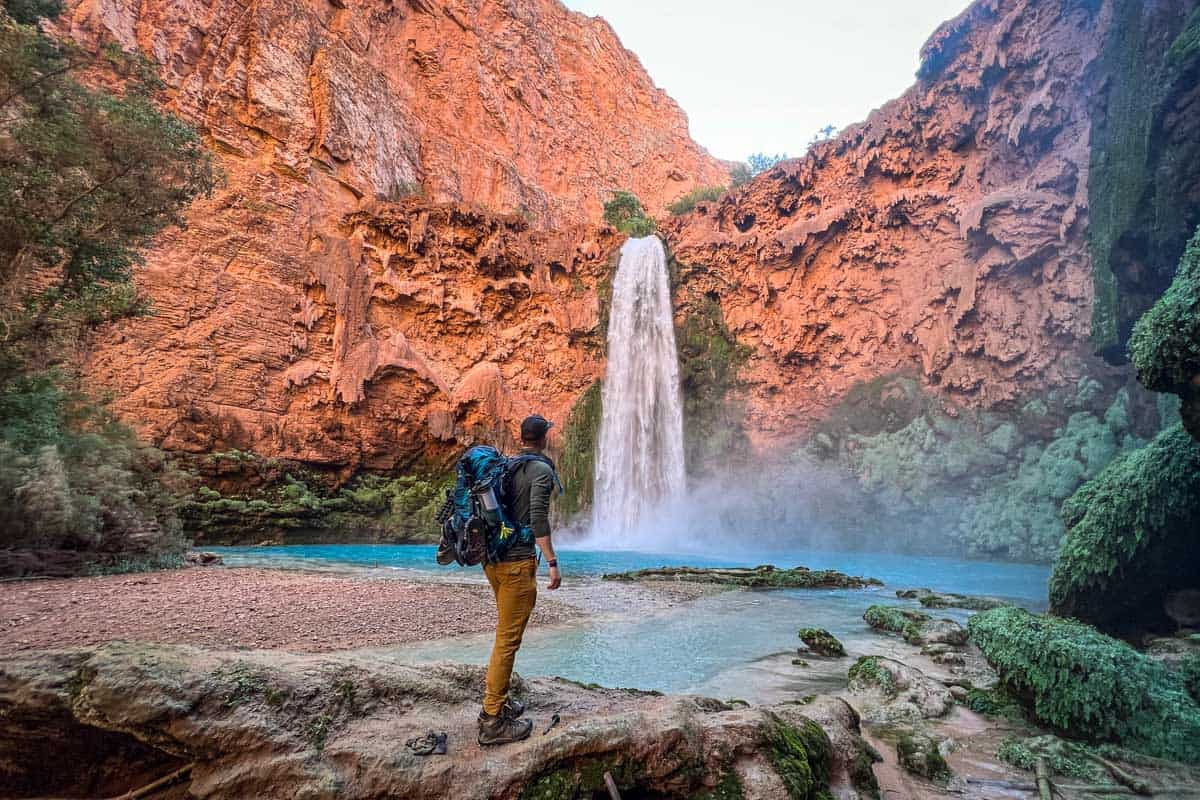
Nestled below the rim of the Grand Canyon, sits the Havasupai Reserve in Arizona. Probably best known as the setting for a bucket list hike to Havasu Falls, a paradise of turquoise waters cascading down vibrant red rocks.
It’s no wonder that this place has become a viral sensation on Instagram over the last decade. And yes, it really is as magical as it sounds.
Planning your Havasu Falls hike requires quite a bit of pre-planning and preparation.
Many people get a little overwhelmed at the prospect of hiking from the rim down into the Grand Canyon (and out again). Plus, the distance of this hike – at 20+ miles round trip – can sound like a lot.
However, I will assure you right now that with the right planning and preparation and the right attitude, the Havasu Falls hike truly won’t be so bad.
We are here to share everything you need to know about hiking to Havasupai so you know exactly what to expect, what to pack, and how to plan your hiking itinerary. Let’s get this adventure started!
Havasupai Hike Guide
- Havasu Falls trail stats
- Havasu Falls hike overview
- Know before you go
- The route to Havasu Falls
- Tips for hiking to Havasu Falls
- Where to camp in Havasupai
- What to pack
Good to know: You’ll see the hike referred to as both ‘Havasu Falls’ and ‘Havasupai’ in this article (and elsewhere on the Internet). Havasu Falls is the actual waterfall, Havasupai is the name of the Native American Reservation the hike and falls are located on.

Havasu Falls trail stats
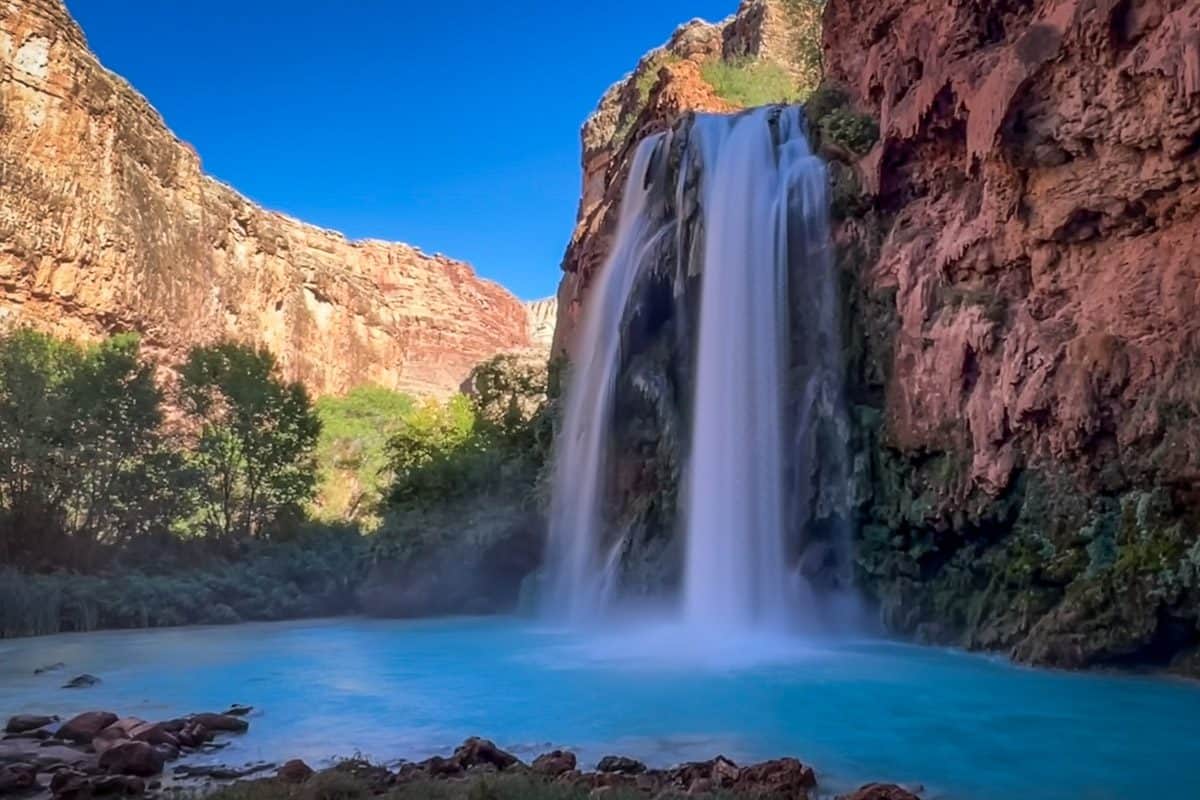
- Location: Havasupai, Arizona, nestled within the Grand Canyon
- Distance: ~20-miles*, out-and-back
- Elevation gain: 2,400 ft
- Difficulty rating: moderate
- Timing: Typically takes 4-7 hours to hike in and 5-8 hours to hike out, it is recommended you spend 2-3 nights there to experience the various falls
- Pets: No pets allowed on the trail
- Permits: Permits are required for both hiking and overnight camping in Havasupai
- View the trail notes
*A note on total distance:
Though the trail indicates 10 miles of hiking, one way, I can assure you that you’ll be covering much more than 20 miles in total during this backpacking adventure.
Determining the exact total distance can be challenging, and will depend on a few factors:
- Camping location: The trailhead is roughly 10 miles away from the campground’s start. The campground itself spans about 1 mile, and if you camp towards the far end (like we did), you’ll likely hike at least 11 miles just to reach your campsite.
- Waterfall visits: The 10-mile distance only accounts for reaching your campsite. You’ll end up hiking additional miles during your time at Havasupai as the main waterfalls are spread out, requiring more hiking to move between them. For instance, the round trip to and from Beaver Falls from the campground totals about 6 miles.
- Confluence hike: Opting for the optional hike to the confluence of the Colorado River adds another 12 miles or more to your journey.
Based on our personal experience, we logged over 40 miles of hiking during our 4-day backpacking trip in Havasupai, which included the Confluence hike.
Havasu Falls hike overview
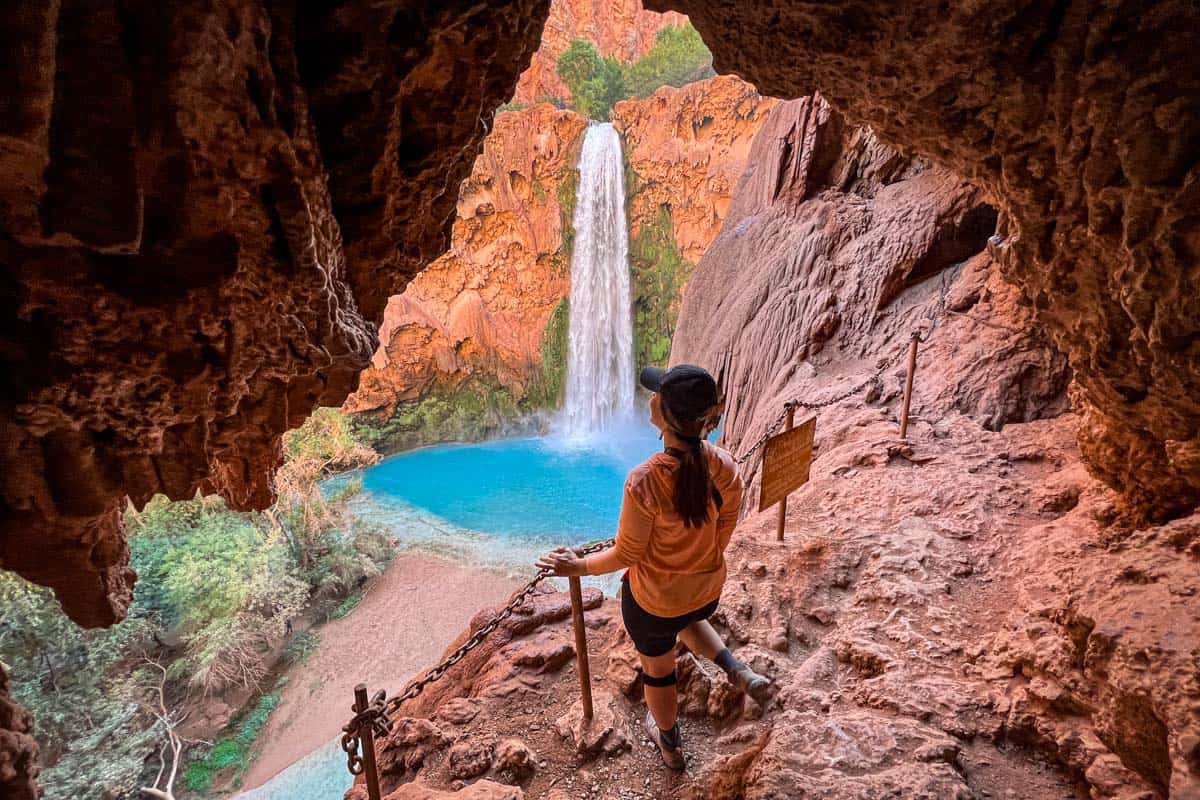
The Havasu Falls hike offers a remarkable journey through the heart of the Grand Canyon, leading adventurers to a series of stunning waterfalls nestled within the Havasupai Indian Reservation.
The trail winds through breathtaking desert landscapes with captivating vistas and natural wonders along the way.
Highlights of the hike include wandering through the town of Supai, encountering a number of majestic waterfalls, swimming in the turquoise pools, and camping overnight in the valley.
Psst! Did you know the Havasu Falls hike trail is one of the best hikes in Arizona!?
Things to know before you go
There are a few things to consider and planning to be done ahead of time before you can begin your Havasu Falls hike.
Best time of year for the Havasu Falls hike

The best time of year to tackle the Havasu Falls hike depends on personal preferences and weather conditions. While the trail is open year-round, hikers should consider factors such as temperature, crowd levels, and seasonal variations in water flow.
While the weather in Arizona is sometimes thought to be warm and sunny year-round, temperatures in the canyon are quite variable and even drop as low as freezing at times.
For this reason, Spring and Fall are the most popular and optimal seasons for hiking to Havasupai. During these seasons, you’re most likely to experience mild temperatures and vibrant landscapes.
Summer brings increased water flow in the falls, but comes with the price of extreme hot weather. Winter hiking is possible but may require additional preparation for cold temperatures.
How long does it take to hike to Havasu Falls?
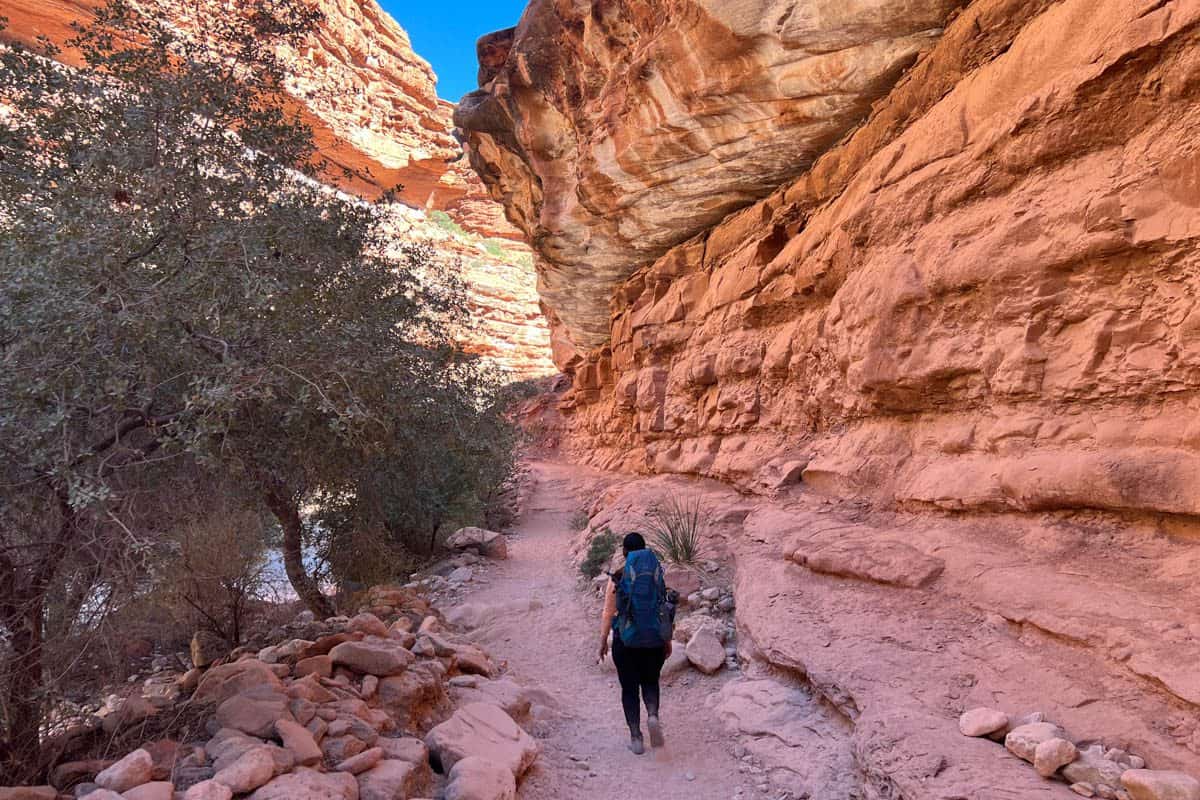
The average time to hike to Havasupai ranges from 4 to 7 hours one way, depending on individual fitness levels, pace, and rest stops.
While some hikers complete the trek in a single day, we do not recommend this. Instead, we would highly recommend taking advantage of the 4-day permit and spending 3 nights camping at the Havasupai campground.
This is how we chose to spread out our Havasupai hike and it gave us enough time to relax and rest our legs, while also getting to explore all of the Havasupai waterfalls and complete the Confluence Hike.
Our experience: We are avid hikers and it took us 4 hours in and 4 hours and 20 minutes out with a few snack and photo breaks sprinkled in.
How difficult is the Havasu Falls hike?
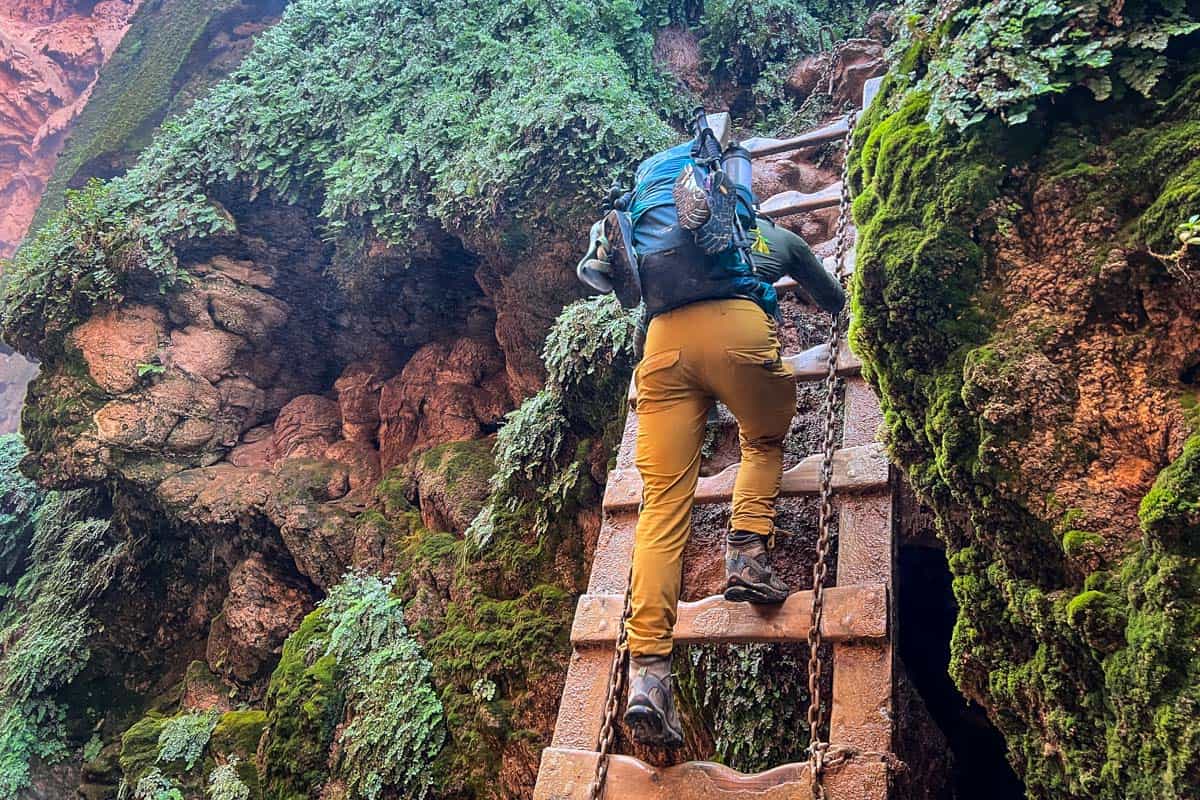
The Havasu Falls hike is rated as moderate in difficulty, requiring a reasonable level of fitness and preparation. However, the answer to this question will really depend more on your personal experience and level of fitness.
While the trail features some challenging sections, including steep switchbacks at the beginning of the descent, most of the hike is relatively flat and manageable. However, hikers should be prepared for the distance and elevation changes, as well as the desert terrain and weather conditions.
Obtaining a permit for your Havasu Falls hike
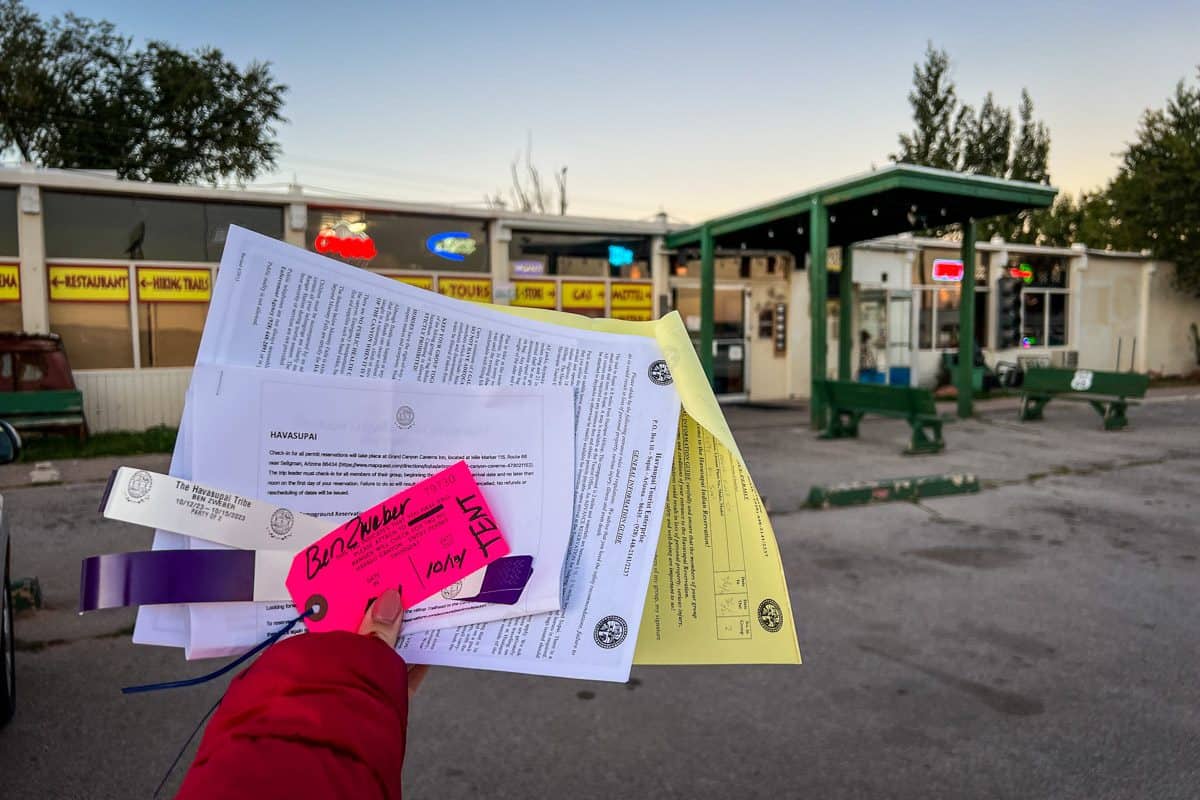
Permits are required for hiking and camping in the Havasupai Indian Reservation and must be obtained through a competitive lottery system.
Hikers must apply for permits well in advance and should be prepared for limited availability and high demand. Additionally, hikers must adhere to the permit regulations, check in at the Grand Canyon Cavern Inn, and display their permits and wristbands at all times during the hike.
We have a complete article on our sister site, Two Wandering Soles, that breaks down exactly what you need to know about getting a permit for your Havasu Falls hike.
The route
We broke down the route for the Havasu Falls hike into parts to give you an idea of what to expect on the trail.
Part I: Descending into the Grand Canyon
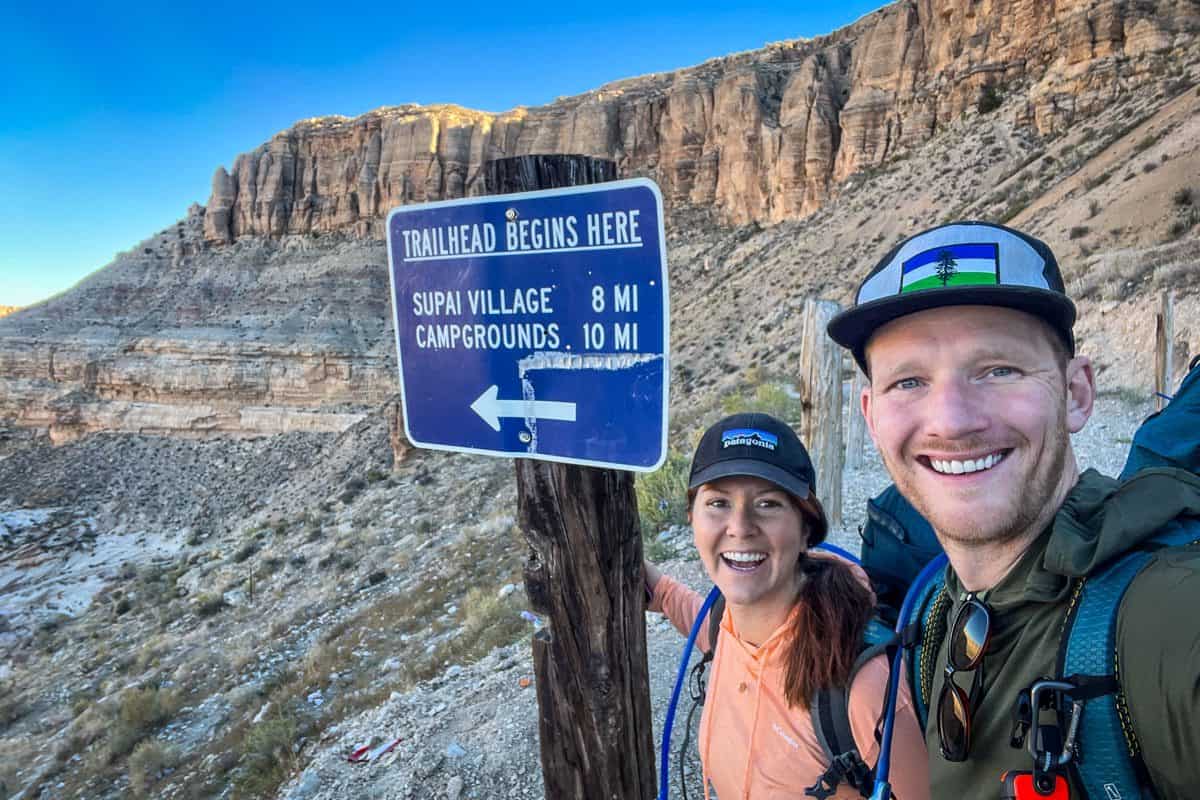
- Mile 0 – 2
Starting your expedition at the Hualapai Hilltop, the initial descent through a series of switchbacks is quicker than expected. As you progress, the trail gradually descends into a narrow canyon, offering a refreshing change of scenery.
This section is exposed to the sun, so we recommend getting an early start which will offer shaded relief from the canyon walls.
Part II: Hiking through a narrow canyon
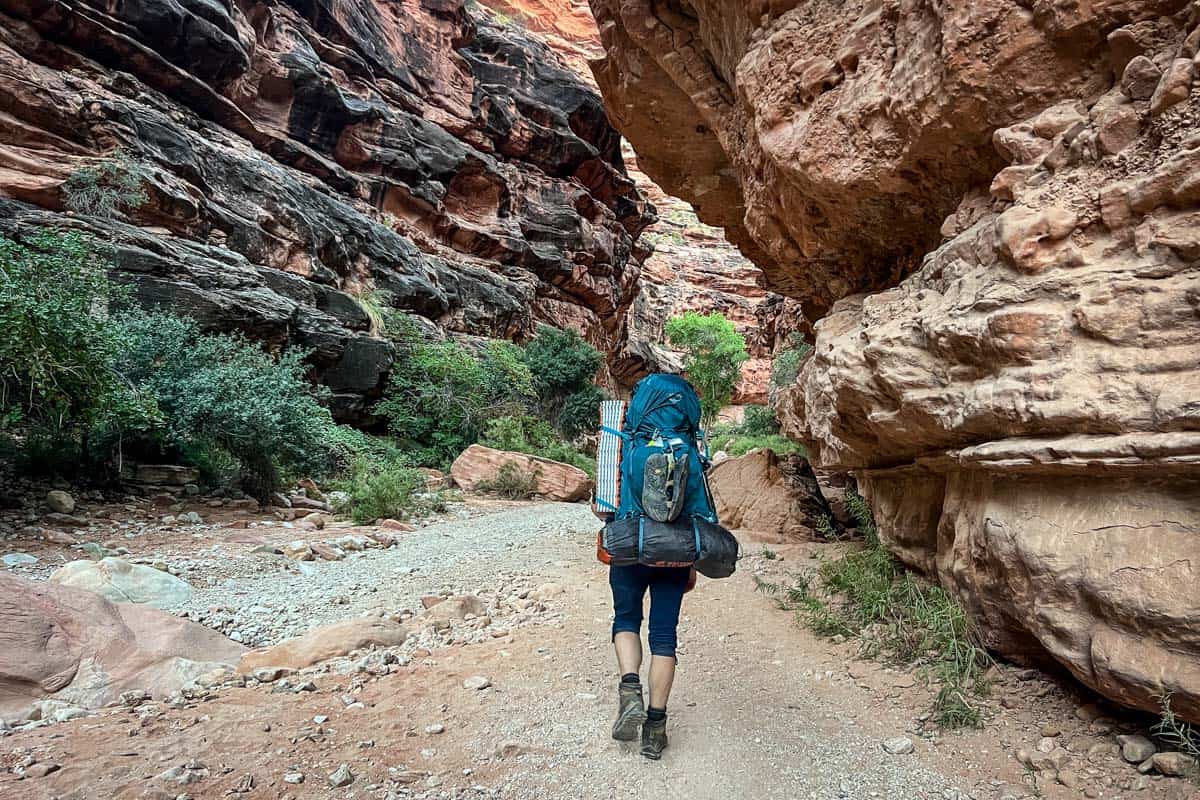
- Mile 2 – 7.5
The subsequent stretch covers approximately 6 miles of mostly flat terrain with a subtle decline.
Walking atop a dry river bed in a narrow canyon, you’ll encounter gravel sections that require good ankle support. However, the breathtaking views and potential shade make this part of the hike enjoyable, especially if you begin early.
Part III: Supai village exploration
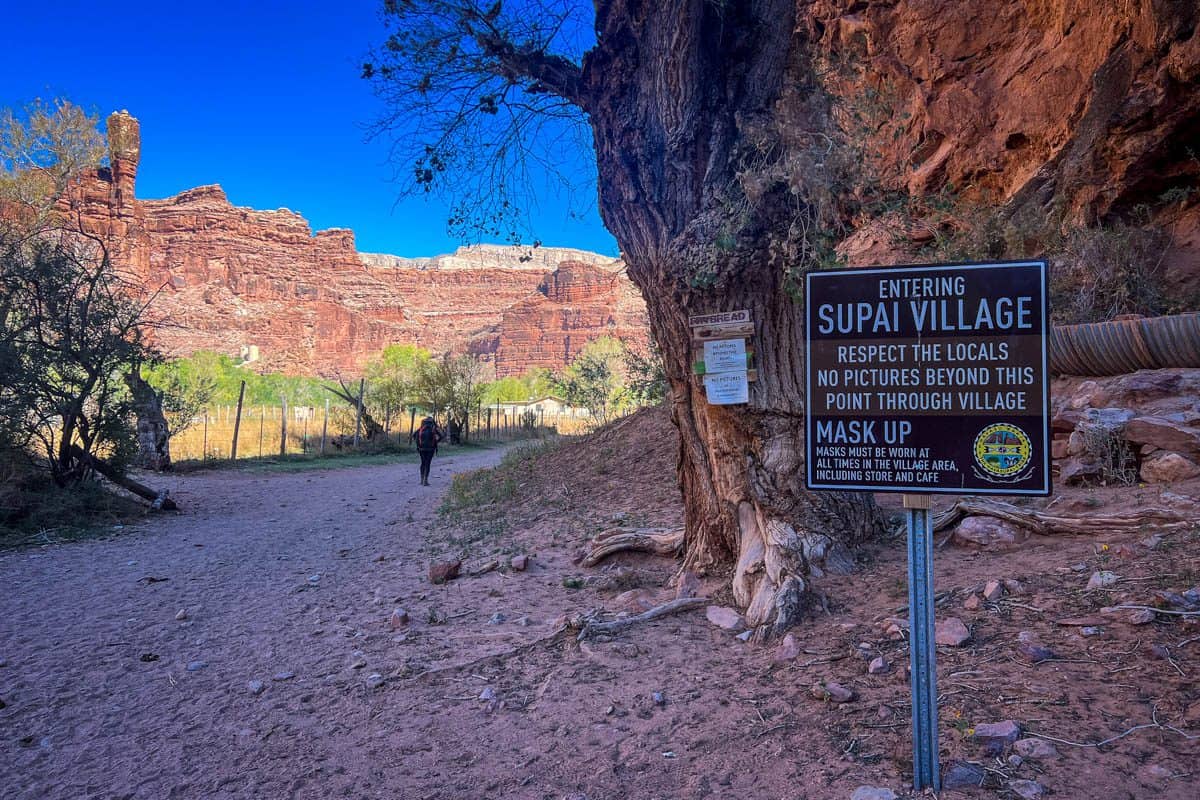
- Mile 7.5 – 8
Around mile 7.5, you’ll reach Supai village, marked by signs prohibiting photography beyond this point. The village offers a glimpse into local life with farmsteads, rock formations, and essential amenities like a medical center, grocery store, and cafe.
Part IV: Passing by enchanting waterfalls
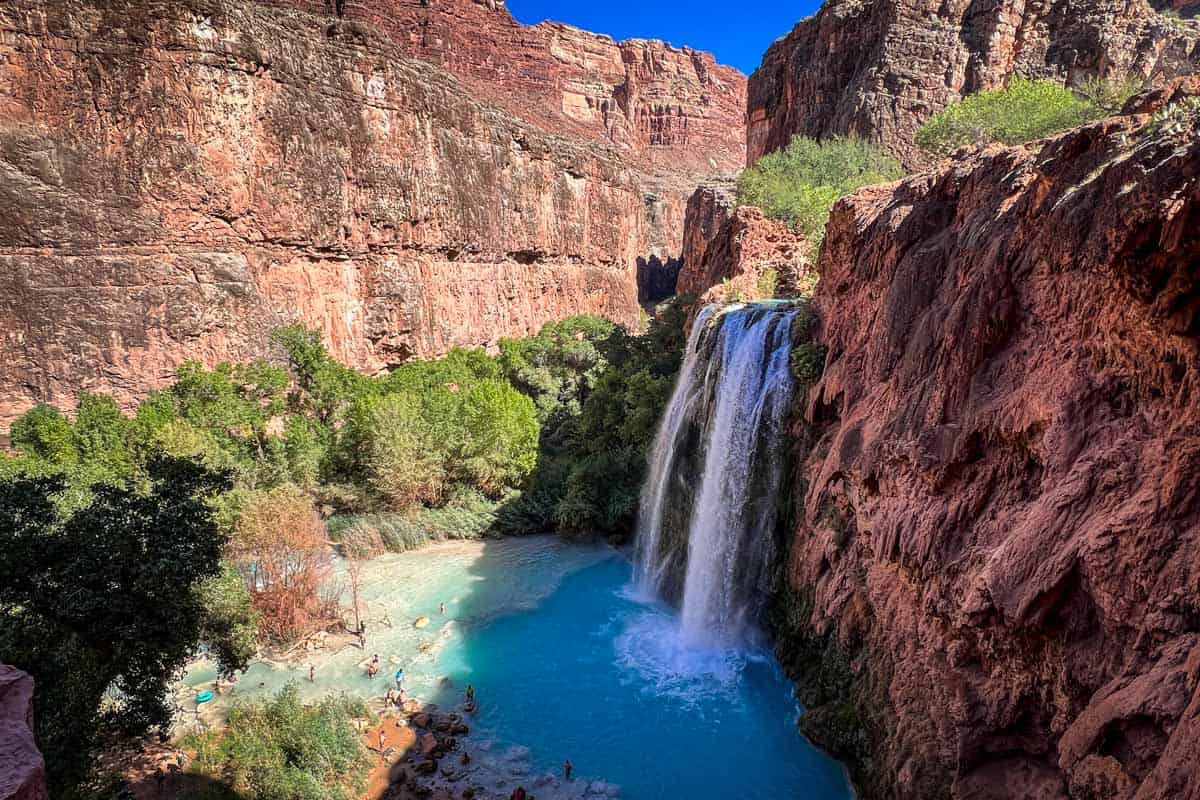
- Mile 8 – 10
Leaving the village, you’ll trek approximately 2 miles to the campground, passing by three stunning waterfalls: Fifty Foot, Lower Navajo, and the iconic Havasu Falls.
We recommend not lingering too long at the falls and instead maintaining a steady pace to secure a campsite. You will have plenty of opportunity to return and savor the sight of Havasu Falls after setting up camp.
Campground experience

Arriving at the campground, you’ll realize that finding a suitable campsite can be a task in itself, given the campground’s size. Be prepared to spend time scouting sites and potentially walking an extra mile if needed.
Hike to the waterfalls at Havasupai
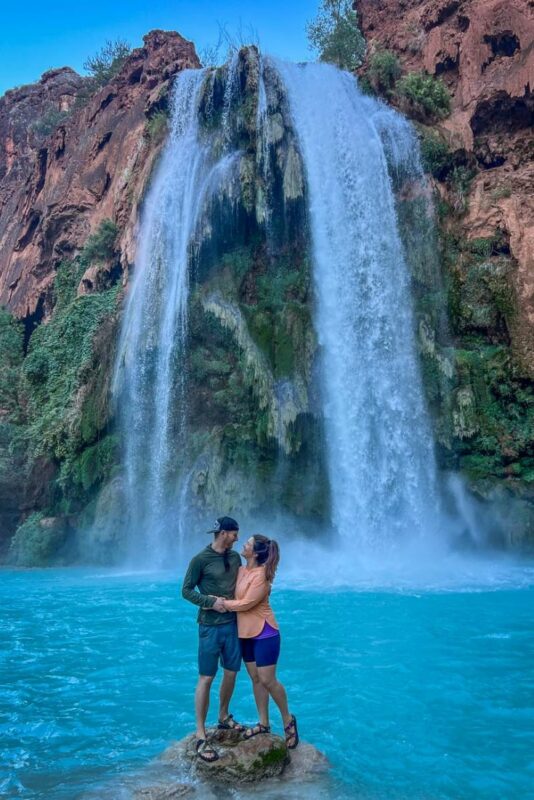

Once you’ve made it to the Havasupai campground and set up camp, your permit allows you to stay for 4 days in total. If you’re hiking in on Day 1 and hiking out on Day 2, you’ll have two days in between to spend relaxing and visiting the various waterfalls in the area.
Because of the distance between the Havasupai waterfalls, we’d recommend splitting up your waterfall hikes into 2 days. Visit Mooney and Beaver Falls together on one day, and Navajo and Fifty Foot Falls on another day.
Havasu Falls is close to the campground area and has a nice area for swimming, so you can plan to visit as many times as you like.
The Confluence Hike
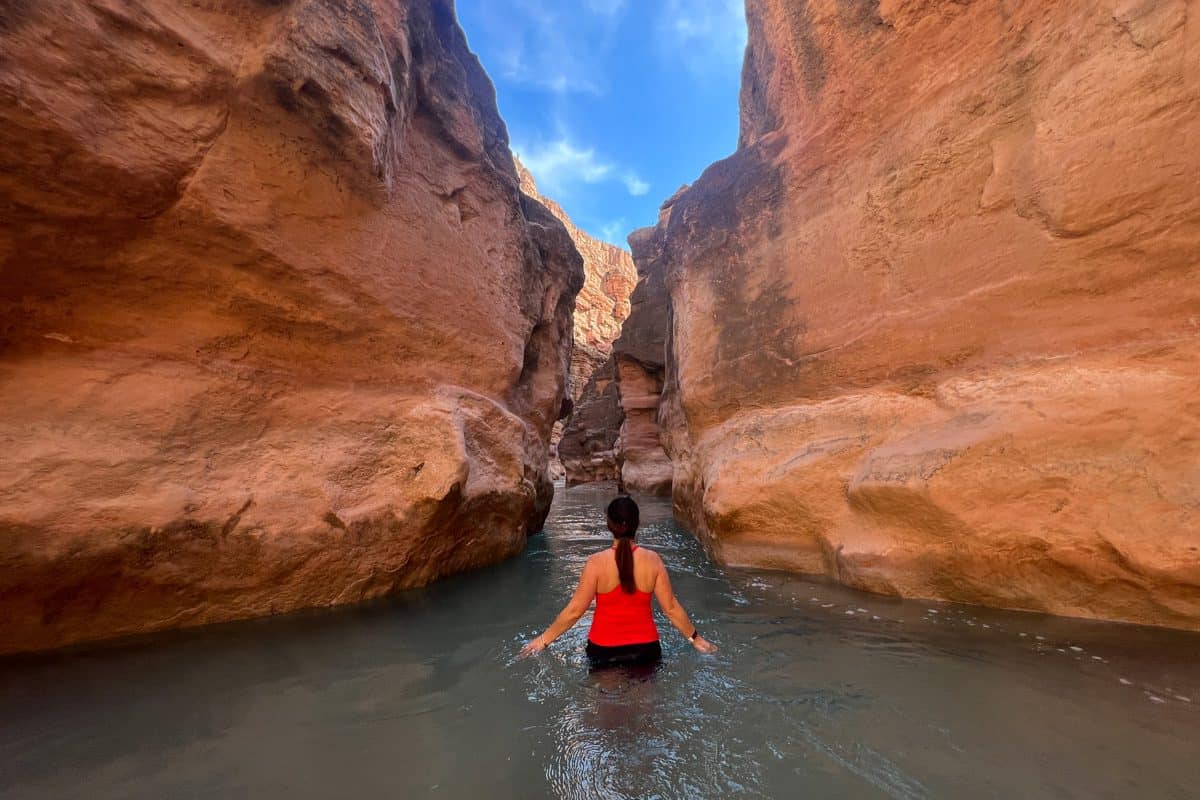
- Distance: 12 miles, out and back
- Elevation gain: 2,975 ft
- Difficulty rating: Challenging
- View the trail notes
There is an optional hike you can take on one of your days in Havasupai called The Confluence Hike. This particular hike marks the juncture where the Havasupai Creek merges with the Colorado River.
It is an epic hike and the trail is notably less crowded than other parts of Havasupai. However, it is challenging! It’s about a 12-mile round-trip journey (from the campsite) on a pretty rugged trail that involves river crossings.
Tip: Combine this hike with your visit to Beaver Falls, which is on the way!
Hiking out of Havasupai

On your return journey, you’ll reverse the trail sections. The hike out will take a bit longer than your hike in since you’ll be gaining elevation.
We recommend getting an early start to beat the traffic on the trail and return to your car at a reasonable time. Plan about 5-8 hours for your hike out.
While there are uphill stretches, particularly noticeable in the final mile with steep switchbacks, the gradual incline makes it manageable. The adrenaline rush from nearing the parking lot often eases any challenges encountered along the way.
Tips for hiking Havasupai
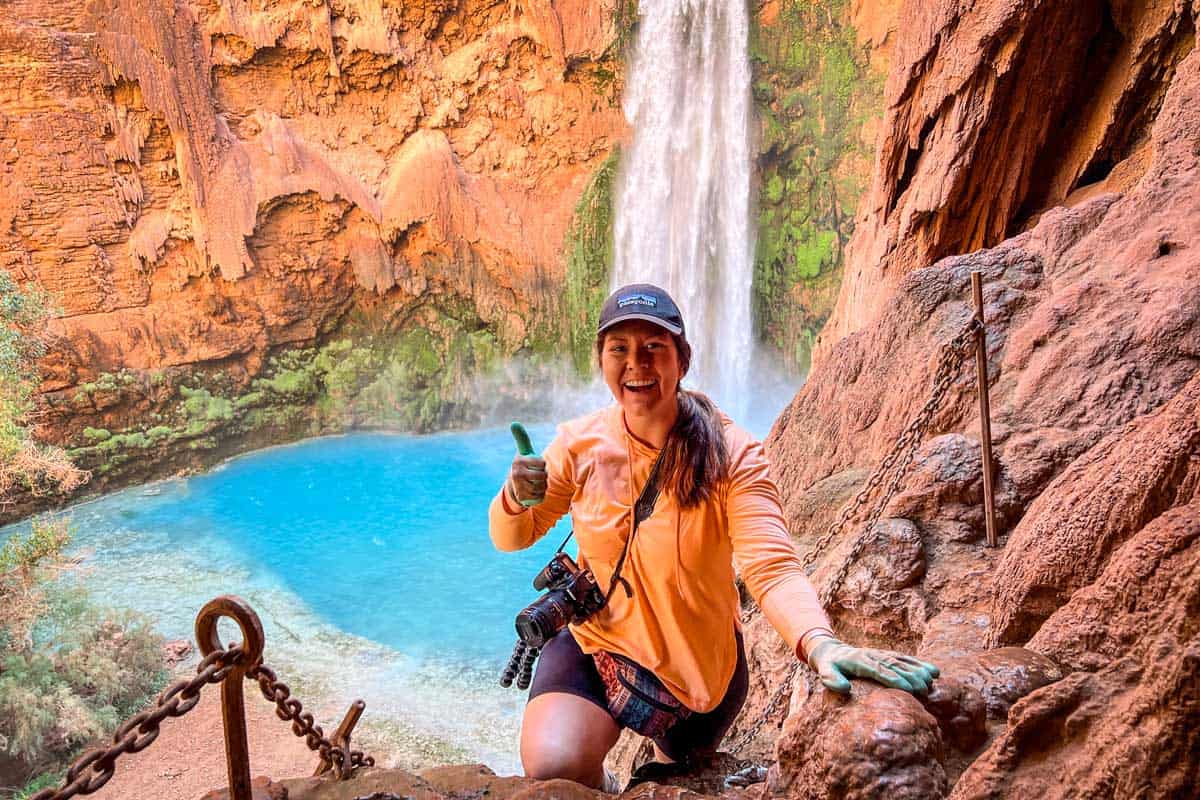
We picked up some helpful tips from our own experience hiking the Havasupai trail.
- Plan and prepare for your Havasu Falls hike well in advance. Preparation includes obtaining permits, packing appropriate gear, and familiarizing yourself with the trail.
- Stay hydrated and carry an ample water supply, as water sources are limited along the trail. Though there is natural spring where you can fill up at the campsite.
- We recommend bringing 3L of water per person on the Havasu Falls hike
- Protect yourself from the sun with sunscreen, sunglasses, and protective clothing, especially during hot weather.
- Use the bathroom at the trailhead parking lot. There are no restrooms on the trail until you reach Supai Village (about 8 miles into your hike).
- Start your hike early. The first 3 or so miles of the hike into the canyon are fairly exposed, but if you get an early enough start, you will still get some shade from the canyon walls.
- Practice Leave No Trace principles and respect the natural environment and cultural heritage of the Havasupai tribe.
- Stay on designated trails and follow all posted regulations and guidelines to ensure a safe and enjoyable hike.
- Get a campsite before checking out the waterfalls. The scramble to get a good campsite is real. We wound up walking around the campsite for another hour or so before we found a good spot to wedge our tent in between others. Though it may be tempting to stop and oogle at the waterfalls when you first arrive, you’ll have plenty of time for oogling after setting up camp.
- Leave a jug of water and some snacks in your car for when you return to the parking lot after your hike out.
- Make sure you have a full tank of gas. The trailhead parking lot is sort of in the middle of nowhere, without any gas stations around for miles. Having a full tank of gas when you arrive will ensure you don’t get started on your drive out.
Where to camp at Havasupai
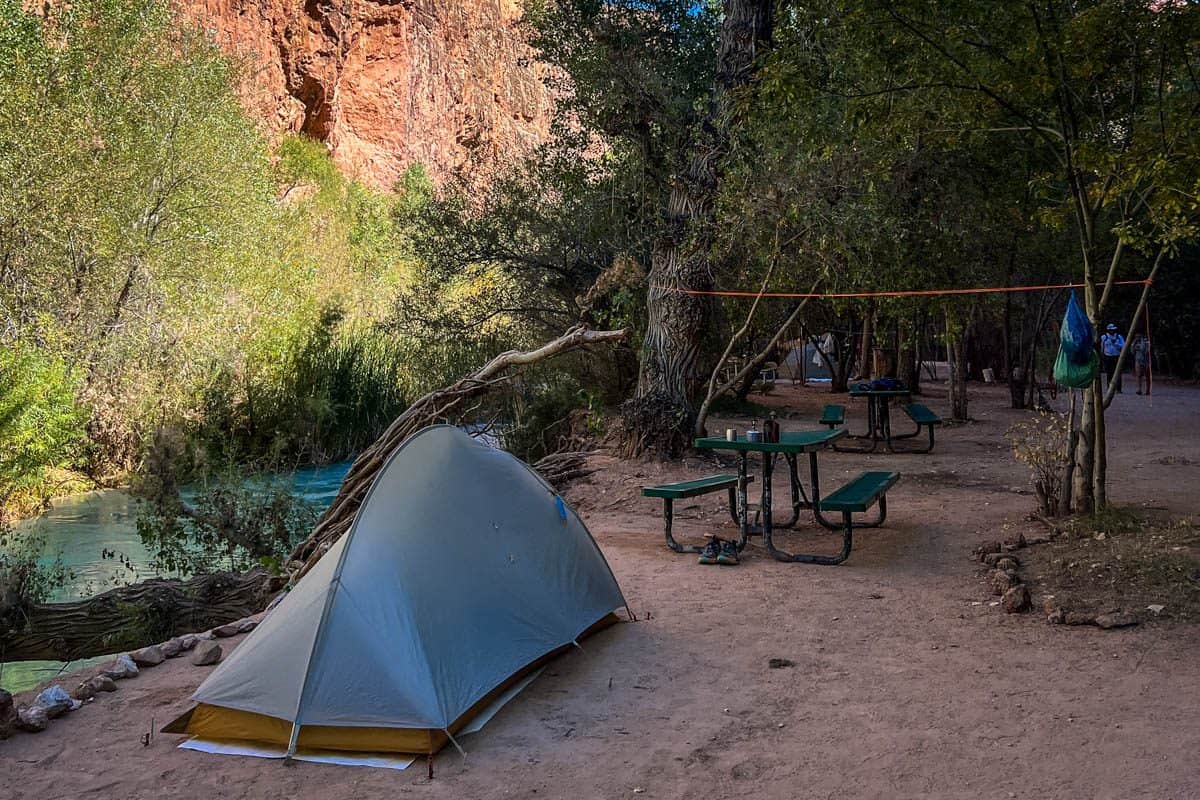
Camping is available at the Havasupai Campground, located near Havasu Falls.
The campground offers basic amenities, including restrooms and picnic tables, and campsites are available on a first-come, first-served basis.
Things to know about the Havasupai Campground
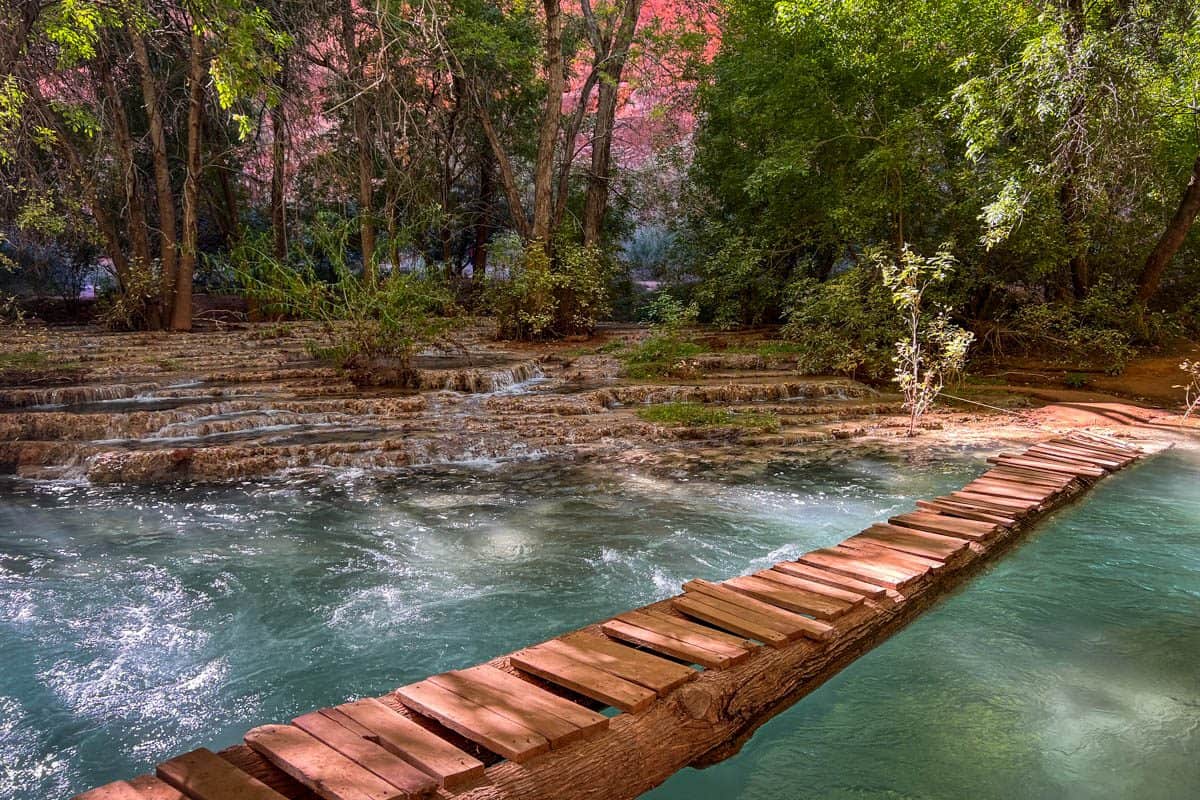
- The campground spans one mile in length. If you find a spot at the far end, you’ll have to factor an extra mile into your hiking.
- Havasu Falls and Mooney Falls bookend the campground, with Havasu Falls located closer to the beginning and Mooney Falls near the opposite end. The campground’s prime location along Havasupai Creek ensures that many campsites are conveniently close to the water’s edge.
- While navigating the area, you’ll encounter makeshift bridges over parts of the river, which offer access to additional campsites on the opposite bank.
- Most campsites lack significant privacy, fostering a communal atmosphere where tent neighbors often become trail companions.
- Due to its popularity, the campground consistently accommodates between 300 to 400 campers nightly. Arriving early is crucial for securing a desirable campsite, underscoring the importance of beginning your hike early on Day 1.
- Facilities within the campground include three toilet blocks strategically positioned at the beginning, middle, and end sections. Additionally, a water fill-up station known as “Fern Spring” provides access to spring water via a continuously running spigot.
- While the water doesn’t require filtering, we recommend using an additional filtration device (such as a Steripen or Grayl self-filtering water bottles) as a precaution.
What to pack for the Havasu Falls hike

The Havasupai hike is a unique backpacking experience that requires particular gear. We’ve listed out exactly what we brought below.
Essentials
- Printed out permit**
- Photo ID
- When checking in at the Grand Canyon Cavern Inn, trip leaders must present their photo ID along with their printed permit.
- Cash
- You’ll need cash if you want to eat at the Indian fry bread stand at Havasu Falls or the cafe in town. It’s also a good idea to have on you in case of emergency.
- Navigation: we recommend using Alltrails+ to download the offline trail map
- Get your first week of using Alltrails+ for FREE when you sign up using our link!
- Portable battery charger (this is our favorite one that can hold 5 charges)
- First aid kit (make sure you have blister prevention, like moleskin!)
- Before your hike, be sure it is well-stocked and replace any necessary items.
- Garmin InReach Mini
- We hiked for many years without this, but now that we have it, we think it’s an essential – especially when we’re in an area with zero cell service and potentially very hazardous conditions.
Backpacking gear

- Hiking backpack
- a rain cover is recommended too, especially if you’re hiking during monsoon season
- Lots of layers (here is a great resource if you’re wondering what to wear hiking)
- Comfortable hiking boots or shoes
- Hiking poles (optional)
- Packing cubes or stuff sacks to keep items compressed and organized
- Headlamp
- Dry bag (we always carry one with us for our valuables in case of rain)
- Camera/tripod (this one’s our favorite for hiking)
- Multi-tool
- Duct tape
- Lightweight tent: find out the best 2-person tents for camping and backpacking
- Sleeping bag
- Check out the average temperatures in Havasupai during the month you’ll be visiting to make sure your sleeping bag is sufficient!
- Ultralight inflatable sleeping pad (this is the one we use)
- Foam pad: Layer a foam pad with your inflatable sleeping pad for maximum comfort!
- Camping pillow (optional – we have this one)
- Microfiber towel or sarong
Toiletries
- Bug repellant (especially if you’re visiting Havasupai from May – September)
- Sun protection: sunscreen, hat, sun glasses
- Toilet kit: toilet paper, lightweight poo shovel, bag for packing out TP, Kula cloth
- Hand sanitizer (my all-time favorite hand sani!)
- Chapstick
- Wipes
- Toothbrush, toothpaste, & floss
- Deodorant
Food & Water
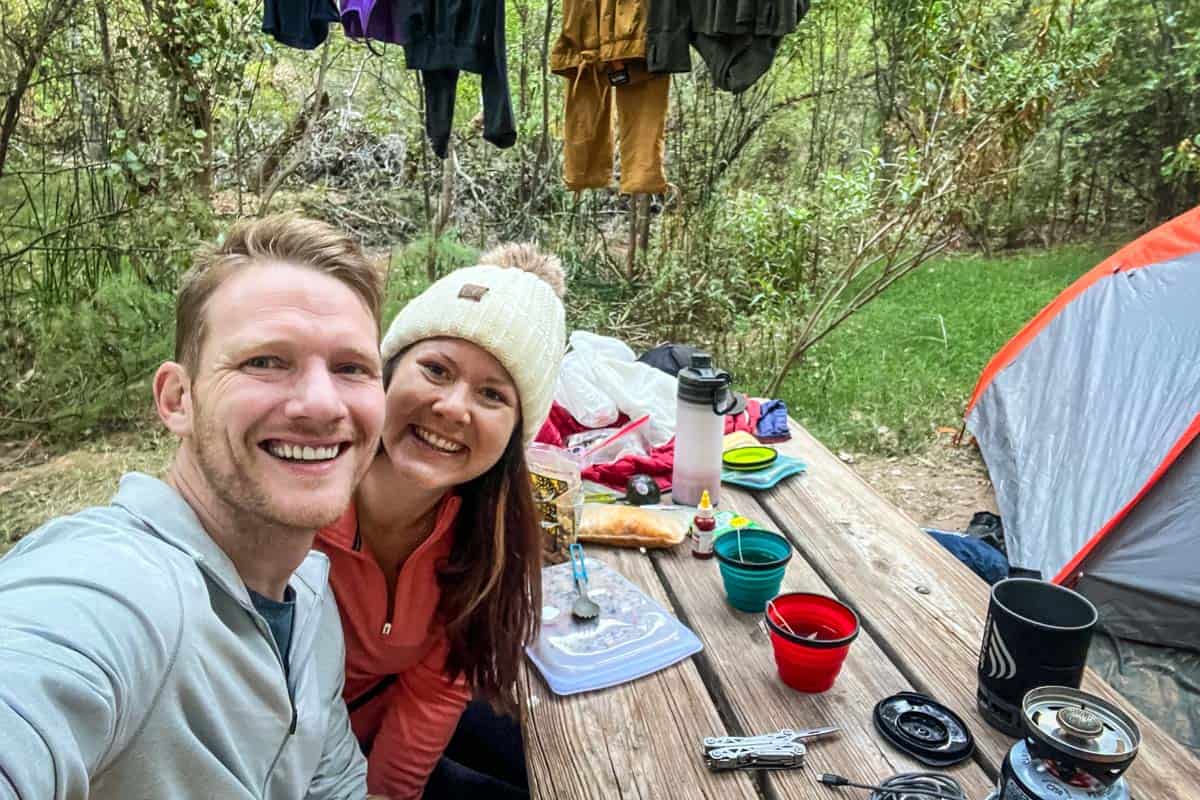
- Water bottles and/or bladder for your Camelbak
- We highly recommend bringing a bladder as it makes it so much easier to carry large amounts of water and to hydrate while hiking (without needing to stop)
- Make sure you fill this with water before driving to the trailhead as there is no water fill there.
- Way to purify your water (we love our Grayl water bottles, and before them we always brought along our Steripen)
- Dehydrated meals
- These are our go-to tips for backpacking food
- Note: There are a few limited food options within Havasupai
- Plenty of snacks: check out our favorite hiking snacks here!
- Electrolyte tablets (we like these)
- Tea bags for at night (optional)
- Aeropress, coffee grounds, and collapsible cups (optional)
- Camp stove/fuel (we love our Jetboil!)
- Don’t forget propane, but FYI: you can’t fly with this!
- Lighter and/or matches
- Utensils
- Collapsible bowls
- Cookware if necessary
- We’d recommend just boiling water in a Jetboil or something similar instead of cooking in a pot. You can simply add boiling water to your dehydrated meal pouch, eliminating the need to do lots of dishes.
- Bag for your trash
- You should plan to pack everything you brought out with you (including trash)
- Mess kit:
- Small bottle of biodegradable soap
- Small microfiber towel for drying dishes and other gear
- Bear canister or food storage bag (we use this one that is designed to keep critters out)
*Don’t forget to pack your permit!
Be sure to download our FREE hiking packing list before your next trip and never leave another essential behind again!
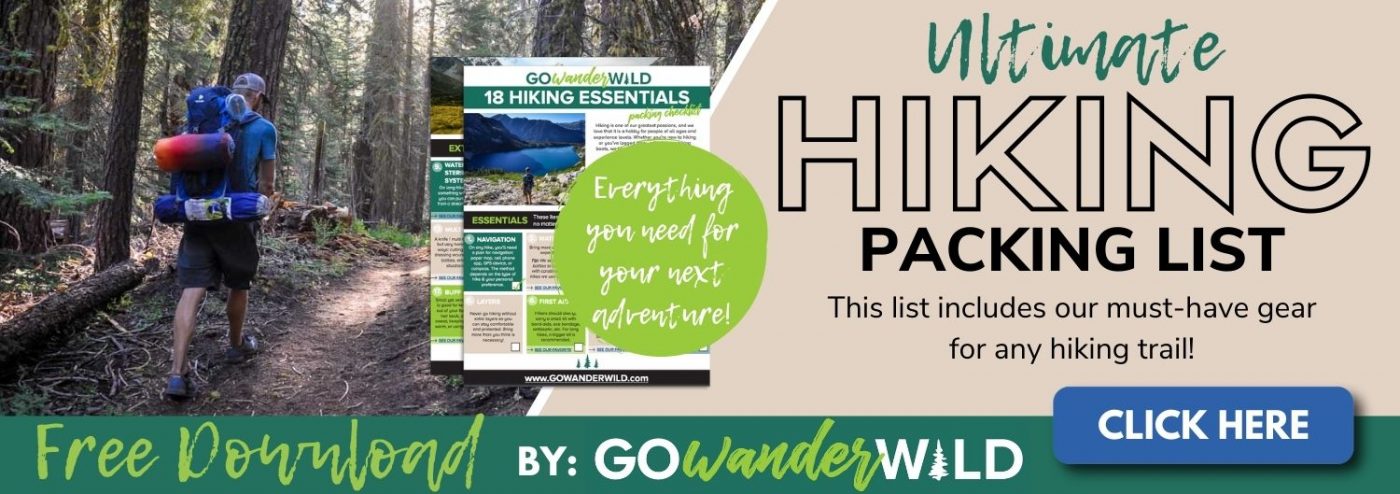

You may also like…
- Best Hikes in Sedona, Arizona for All Levels
- Backpacking for Beginners: Ultimate Guide
- What to Wear Hiking in Every Season
- Best Hiking Snacks: Healthy & Delicious Trekking Food
Save this article on Pinterest for later!
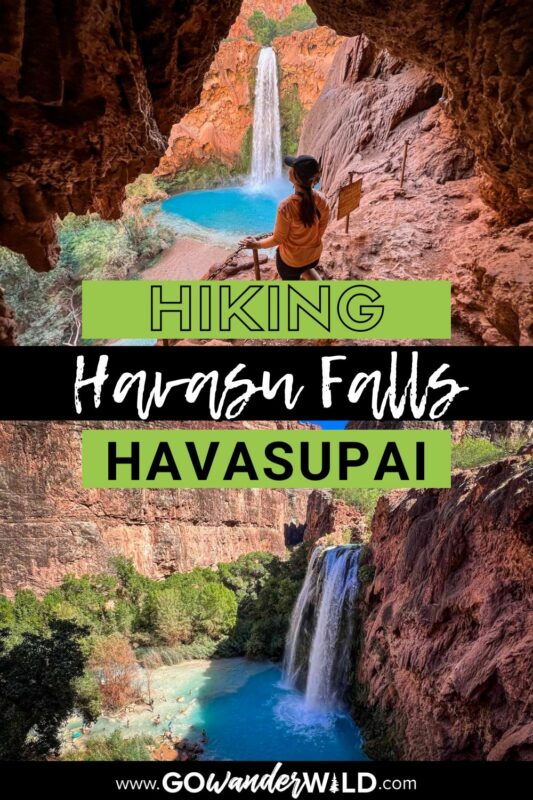
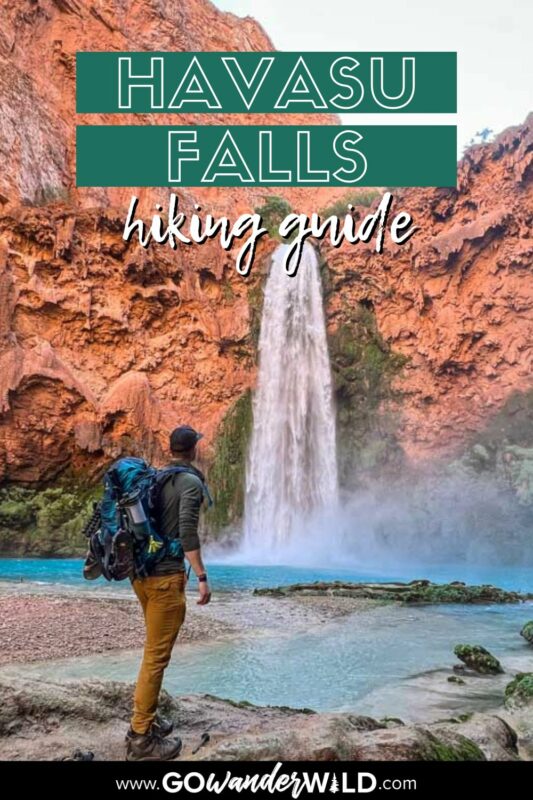
We want to hear from you!
Have you done the famous Havasu Falls hike in Arizona? What was your experience like? Are you planning a trip to Arizona for hiking and want more advice? Comment below and let us know!

